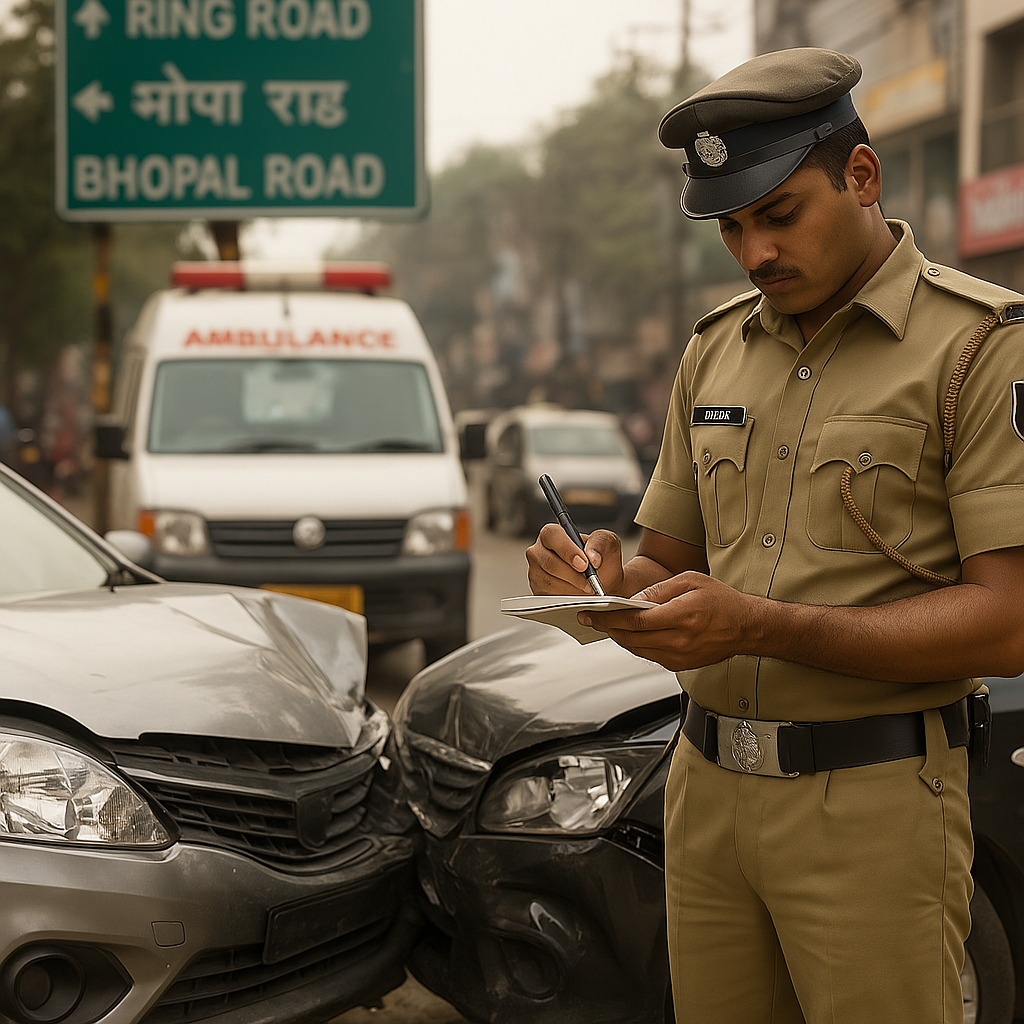Motor vehicle accidents are a rising concern in India, causing significant injury, death, and property loss each year. To manage the legal consequences of such incidents, Indian law provides two main frameworks: Motor Accident Claims Tribunal (MACT) for civil compensation and criminal laws under the Bharatiya Nyaya Sanhita (BNS) and Motor Vehicles Act to address negligent driving or rash driving. This guide, curated with insights from leading motor accident lawyers in Chandigarh and legal experts on MACT claims, explains how victims can seek compensation and how drivers can defend against criminal liability.
What Is a Motor Accident Under Indian Law?
A motor accident refers to an unexpected event involving one or more vehicles that results in injury, death, or property damage. The Motor Vehicles Act, 1988, defines a motor accident as any incident involving the use of a motor vehicle, whether on public roads or private property.
Key Elements of a Motor Accident:
- Involves a motorized vehicle (car, motorcycle, bus, truck, etc.)
- Occurs on public or private roads
- Leads to injury, death, or property damage
Understanding MACT: Motor Accident Claims Tribunal
The Motor Accident Claims Tribunal (MACT) is a specialized court established under the Motor Vehicles Act, 1988, designed to provide speedy compensation to accident victims or their legal heirs.
Main Functions of MACT:
- Adjudicate compensation claims for personal injury, death, or property damage
- Determine liability of drivers, owners, and insurers
- Assess compensation based on income loss, injury severity, and dependents
- Enforce compensation awards
Filing a Claim with MACT: Negligent Driving Laws in India
Victims or their representatives must file a claim within six months of the accident. MACT advocates in Chandigarh suggest preparing a detailed account and documentation before filing.
Documents Required:
- FIR and accident report
- Medical bills and injury proof
- Vehicle damage estimates
- Proof of income (for loss of earnings)
- Death certificate and legal heir documents (in fatal cases)
Who Can File a MACT Claim?
According to Section 166 of the Motor Vehicles Act:
- Injured individuals
- Legal heirs of a deceased person
- Property owners affected by the accident
- Authorized representatives
Jurisdiction of MACT:
Claims can be filed where:
- The accident occurred
- The claimant resides
- The defendant resides or conducts business
How Compensation Is Calculated in MACT Cases
In Sarla Verma v. DTC (2009), the Supreme Court standardized compensation calculation through the multiplier method.
Key Compensation Factors:
- Annual Income of the deceased or injured
- Future Prospects (additional income assumption)
- +50% if under 40
- +30% if 40–50
- +15% if 50–60
- Deductions based on personal expenses:
- 1/3rd for married persons
- 50% for unmarried individuals
- Multiplier Based on Age:
- E.g., Age 25 → Multiplier = 17
- Age 40 → Multiplier = 14
- Non-Pecuniary Damages:
- Loss of consortium
- Funeral expenses
- Pain and suffering
Criminal Liability in Motor Accidents: Negligent Driving Laws in India
While MACT addresses civil claims, criminal charges can be filed against negligent or rash drivers under the Bharatiya Nyaya Sanhita (BNS) and Motor Vehicles Act.
Common Acts of Negligence:
- Rash or reckless driving
- Driving under the influence
- Distracted driving (e.g., mobile phone use)
- Disobeying traffic laws
- Poor vehicle maintenance
Relevant Legal Provisions:
| Provision | Law | Penalty |
| Section 281, BNS | Rash driving | Up to 6 months’ imprisonment, fine or both |
| Section 106(1), BNS | Causing death by negligence | Up to 5 years’ imprisonment, fine |
| Section 106(2), BNS | Hit and run causing death | Up to 10 years’ imprisonment, fine |
| Section 125(a)(b), BNS | Causing hurt by endangering life | Up to 3 years’ imprisonment, fine |
| Section 185, Motor Vehicles Act | Driving under the influence | Imprisonment, fine, or both |
Defences in Negligent Driving Cases
Experienced criminal lawyers and advocates in Chandigarh often use the following defences to protect clients in negligent driving charges:
- No Negligence: Driver followed all rules; accident was unavoidable.
- Contributory Negligence: Victim also acted negligently (e.g., jaywalking).
- Medical Emergency: Sudden health crisis led to loss of control.
- Mechanical Failure: Unforeseeable breakdown caused the crash.
- No Causation: Injury was pre-existing or unrelated to the accident.
Appeals and Legal Recourse on Negligent Driving in India
If dissatisfied with MACT’s decision, parties can appeal to the High Court under Section 173 of the Motor Vehicles Act within 90 days, provided they deposit ₹25,000 or 50% of the awarded amount (whichever is less).
Understanding both MACT procedures and criminal law implications is essential for anyone involved in a motor vehicle accident in India. While MACT ensures compensation for victims, criminal laws enforce driver accountability to promote road safety.
Whether you are a victim seeking compensation or a driver facing criminal charges, consulting experienced motor accident lawyers in Chandigarh or negligent driving advocates in Punjab and Haryana High Court can ensure your rights are protected and your case is handled with legal precision.
FAQs on Motor Accident Claims and Negligent Driving Laws in India
1. How do I file a MACT claim for a road accident in Chandigarh?
To file a MACT claim in Chandigarh, you must submit a detailed application to the Motor Accident Claims Tribunal in your jurisdiction. The application should include an FIR copy, medical reports, proof of income, and documentation of injuries or property loss. For guidance, it’s best to consult experienced MACT lawyers in Chandigarh familiar with local tribunal procedures.
2. What compensation can I claim in a motor vehicle accident case in India?
Under the Motor Vehicles Act, victims can claim compensation for medical expenses, income loss, pain and suffering, property damage, and in case of death, loss of consortium and funeral expenses. The compensation is calculated using the multiplier method, as defined in Supreme Court rulings. Motor accident advocates in Chandigarh can help ensure accurate calculation and fair representation.
3. Is negligent driving a criminal offense in India?
Yes, negligent driving in India is a punishable criminal offense under the Bharatiya Nyaya Sanhita (BNS) and the Motor Vehicles Act. Offenses like rash driving, drunk driving, or hit-and-run incidents can result in imprisonment, fines, or license suspension. High court lawyers in Punjab and Haryana often handle such cases where both civil and criminal liabilities arise.
4. Can I appeal a MACT decision in the Punjab and Haryana High Court?
Yes, you can file a MACT appeal in the Punjab and Haryana High Court under Section 173 of the Motor Vehicles Act within 90 days of the tribunal’s decision. The appeal process requires legal documentation and a deposit of a portion of the compensation amount. Consult experienced MACT appeal advocates in Chandigarh to navigate the process efficiently.
5. Who is liable in a road accident claim: the driver, owner, or insurance company?
In most road accident claims in India, liability is determined based on negligence, vehicle ownership, and insurance coverage. Often, the driver, vehicle owner, and insurer can be jointly liable. Top motor accident lawyers in Chandigarh evaluate each case to establish who bears financial responsibility, ensuring that victims receive full and fair compensation.

